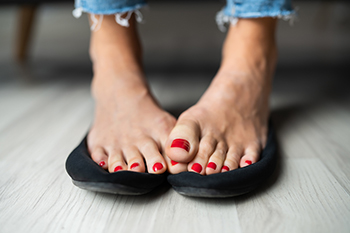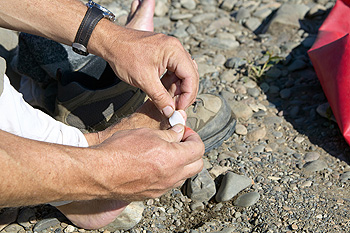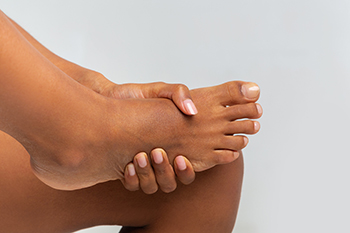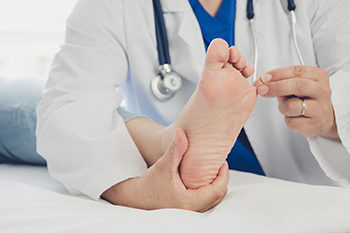

If you are exercising a lot, or the weather is very hot, your feet may perspire more than normal. But if you find that your feet sweat for no particular reason when you are at rest, you may have a condition known as plantar hyperhidrosis. Although the cause of hyperhidrosis is still unknown, medical experts have determined that the brain signals to the sweat glands that your body is overheating. As a result, the sweat glands in several parts of the body, including the soles of your feet, work overtime to regulate your body temperature. It is not known how to eliminate hyperhidrosis completely, but a number of temporary measures can keep it controlled. Treatment options, which vary with the severity of the condition, include topical gels or lotions, injections, and oral medication. Another treatment option is iontophoresis, which involves sending a mild electrical current through a foot bath to temporarily shut down the sweat glands in the feet. For guidance on which treatment options are best for you, a visit with a podiatrist is suggested.
If you are suffering from hyperhidrosis contact Dr. Harris L. Klear of Burlington County Podiatry Associates. Our doctor can provide the care you need to attend to all of your foot and ankle needs.
Hyperhidrosis of the Feet
Hyperhidrosis is a rare disorder that can cause people to have excessive sweating of their feet. This can usually occur all on its own without rigorous activity involved. People who suffer from hyperhidrosis may also experience sweaty palms.
Although it is said that sweating is a healthy process meant to cool down the body temperature and to maintain a proper internal temperature, hyperhidrosis may prove to be a huge hindrance on a person’s everyday life.
Plantar hyperhidrosis is considered to be the main form of hyperhidrosis. Secondary hyperhidrosis can refer to sweating that occurs in areas other than the feet or hands and armpits. Often this may be a sign of it being related to another medical condition such as menopause, hyperthyroidism and even Parkinson’s disease.
In order to alleviate this condition, it is important to see your doctor so that they may prescribe the necessary medications so that you can begin to live a normal life again. If this is left untreated, it is said that it will persist throughout an individual’s life.
A last resort approach would be surgery, but it is best to speak with your doctor to find out what may be the best treatment for you.
If you have any questions please feel free to contact one of our offices located in Marlton and Delran, NJ . We offer the newest diagnostic and treatment technologies for all your foot and ankle needs.

A blister that forms on the skin of the feet is a common response to excess friction from shoes, or from an injury. It is defined as the body’s natural defense mechanism to protect damaged skin. A small area that is filled with liquid can form over the raw skin, and this protects the skin as new skin develops. It is important to cover the blister, and this can help to avoid premature popping. A loose elastic bandage generally works well, or some people use a padded bandage. When new skin has grown, the blister is no longer needed, and will gradually drain. Common reasons for patients to develop blisters can include wearing shoes that do not fit correctly, having an allergic reaction, or possibly from severe sunburn. Additionally, blisters may form from wearing damp socks, and it can help to wear socks that can absorb moisture. If a chemical spills on the feet, the result may be a blister forming. If you have blisters on your feet that are recurring, or if a blister has become infected, it is suggested that you consult with a podiatrist who can help you with treatment options.
Blisters may appear as a single bubble or in a cluster. They can cause a lot of pain and may be filled with pus, blood, or watery serum. If your feet are hurting, contact Dr. Harris L. Klear of Burlington County Podiatry Associates. Our doctor can provide the care you need to keep you pain-free and on your feet.
Foot Blisters
Foot blisters are often the result of friction. This happens due to the constant rubbing from shoes, which can lead to pain.
What Are Foot Blisters?
A foot blister is a small fluid-filled pocket that forms on the upper-most layer of the skin. Blisters are filled with clear fluid and can lead to blood drainage or pus if the area becomes infected.
Symptoms
(Blister symptoms may vary depending on what is causing them)
Prevention & Treatment
In order to prevent blisters, you should be sure to wear comfortable shoes with socks that cushion your feet and absorb sweat. Breaking a blister open may increase your chances of developing an infection. However, if your blister breaks, you should wash the area with soap and water immediately and then apply a bandage to the affected area. If your blisters cause severe pain it is important that you call your podiatrist right away.
If you have any questions, please feel free to contact one of our offices located in Marlton and Delran, NJ . We offer the newest diagnostic and treatment technologies for all your foot care needs.

The arch of the foot is affected by a condition that is known as plantar fibroma. It is defined as an area of fibrous tissue that grows in the arch, and can cause severe pain and discomfort. It starts off as a small lump, and there may be little pain. As it grows, the pain may increase significantly, and it may be difficult to wear shoes. Research has indicated that this condition may develop from a traumatic foot injury which may tear the fascia in the arch. Additionally, there may be existing medical conditions that can contribute to the onset of a plantar fibroma. These can include diabetes, epilepsy, and long-term alcohol abuse. In severe cases, surgery may be a necessary option to remove the mass. There could be complications consisting of infection and the possibility of the fibroma returning. There is usually a simple method of discovering the fibroma, where a podiatrist will press on the arch and the surrounding areas, however they may require additional tests to rule out other disorders. If you have arch pain, it is advised that you schedule an appointment with a podiatrist who can diagnose the condition and discuss correct treatment techniques with you.
A plantar fibroma may disrupt your daily activities. If you have any concerns, contact Dr. Harris L. Klear of Burlington County Podiatry Associates. Our doctor can provide the care you need to keep you pain-free and on your feet.
Plantar Fibroma
A plantar fibroma is a fibrous knot in the arch of the foot. It is embedded in the plantar fascia which is a band of tissue that extends from the heel to the toes along the bottom of the foot. There can be multiple plantar fibromas in the feet at the same time. There are no known causes for this condition. If you have a plantar fibroma, there will be a bump in the arch of your foot that cannot be missed. Any associated pain is most often due to a shoe rubbing against the nodule. Non-surgical options, such as steroid injections, physical therapy, and orthotics should be tried first. Surgery is a last resort and is the only thing that will remove a plantar fibroma entirely. Consult with a podiatrist for a proper diagnosis and to determine the treatment regimen that is right for you.
What Causes a Plantar Fibroma?
While there are no specific causes identified, a plantar fibroma can possibly come from genetic predisposition or the formation of scar tissue that forms from healing the tears in the plantar fascia.
What Are the Symptoms of a Plantar Fibroma?
There will be a noticeable lump in the arch of the foot that may or may not cause pain. If pain is felt, it is typically because a shoe is rubbing up against the lump or when walking or standing barefoot.
Treatment and Prevention
A plantar fibroma will not disappear without treatment, but it can get smaller and be a non-issue. If pain persists, a podiatrist examines the foot and when the arch of the foot is pressed, pain can be felt down to the toes. An MRI or biopsy might be performed to help diagnose or evaluate the plantar fibroma. The following non-surgical options are generally enough to reduce the size and pain of these nodules:
Surgery is considered if the mass increases in size and the patient continues to feel pain after non-surgical methods are tried.
If you have any questions please feel free to contact one of our offices located in Marlton and Delran, NJ . We offer the newest diagnostic tools and technology to treat your foot and ankle needs.

Podiatrists have the letters DPM following their name after they have completed all required education. It is an abbreviation for Doctor of Podiatric Medicine and these types of specialists treat ailments of the foot and ankle. Their mandatory education consists of completing four years of college to obtain a bachelor's degree, followed by four years of training in a podiatric college. A hospital residency is next for continued education where studies involve intense training on feet, ankles, and the conditions associated with them. The entire length of school is a minimum of seven years and may be followed by pursuing a fellowship. If you have a specific foot condition that needs treatment it is beneficial to schedule an appointment with a podiatrist who can effectively diagnose and offer correct treatment techniques rather than an MD who does not specialize in the feet. If this is a career choice you may be considering, visiting with a podiatrist is a good opportunity to decide if this is a desired field of medicine for you.
If you are dealing with pain in your feet and ankles, you may want to seek help from a podiatrist. Feel free to contact Dr. Harris L. Klear from Burlington County Podiatry Associates. Our doctor can provide the care you need to keep you pain-free and on your feet.
What Is a Podiatrist?
A podiatrist is a doctor of podiatric medicine who diagnoses and treats conditions of the foot, ankle, and related structures of the leg. Your podiatrist may specialize in a certain field such as sports medicine, wound care, pediatrics, and diabetic care. Podiatrists have the ability to become board certified through training, clinical experience, and then taking an exam.
What Do Podiatrists Do?
On a daily basis, a podiatrist may perform the following activities:
It is very important that you take care of your feet. It’s easy to take having healthy feet for granted, however foot problems tend to be among the most common health conditions. Podiatrists can help diagnose and treat a variety of feet related conditions, so it is crucial that you visit one if you need assistance.
If you have any questions please feel free to contact one of our offices located in Marlton and Delran, NJ . We offer the newest diagnostic and treatment technologies for all your foot and ankle needs.